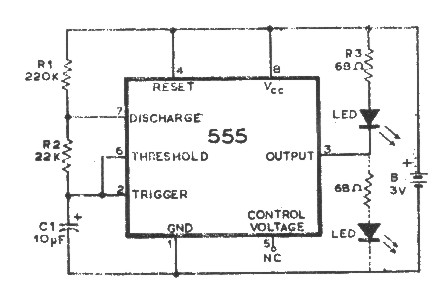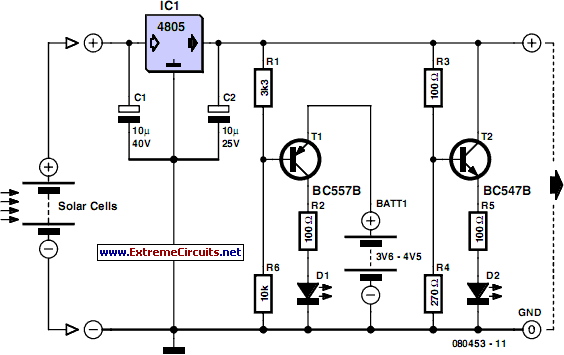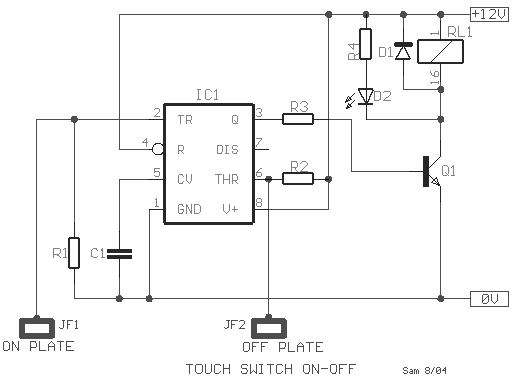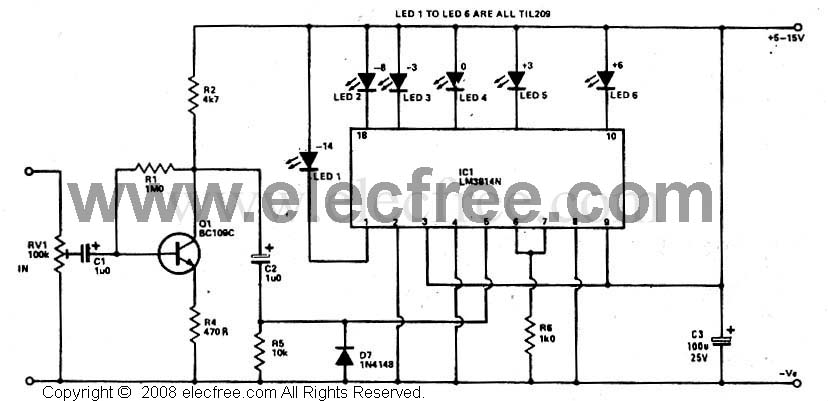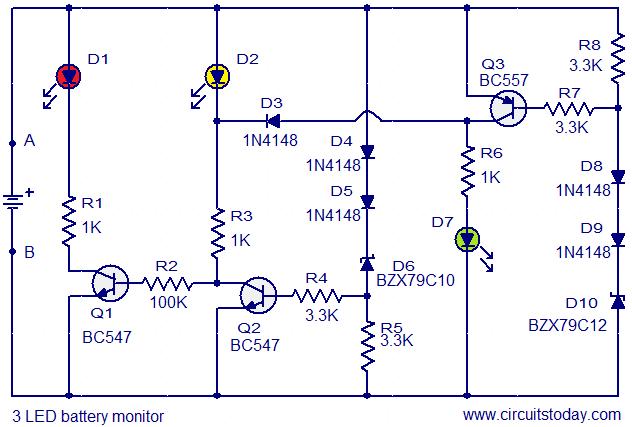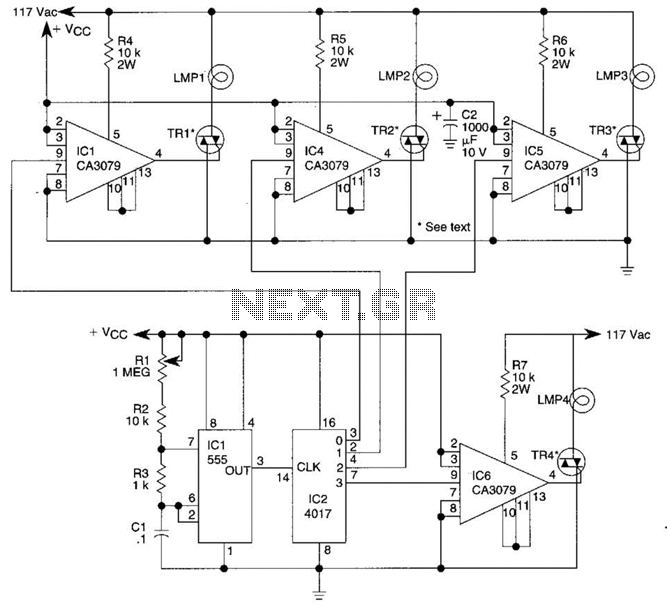
16 Stage Bi-Directional LED Sequencer circuit
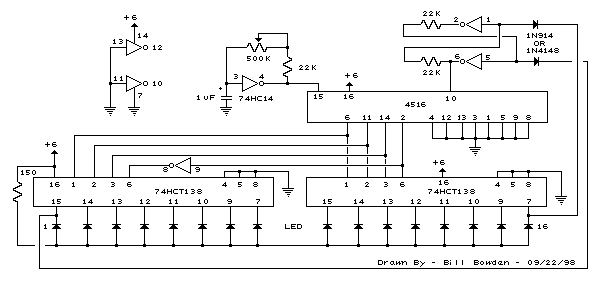
The bi-directional sequencer employs a 4-bit binary up/down counter (CD4516) and two "1 of 8 line decoders" (74HC138 or 74HCT138) to create the well-known "Night Rider" display. A Schmitt Trigger oscillator generates the clock signal for the counter, with the rate adjustable via a 500K potentiometer. Additionally, two Schmitt Trigger inverters are utilized as an ET/RESET latch to manage the counting direction (up or down). It is crucial to use the 74HC14 instead of the 74HCT14, as the latter may not function correctly due to its low TTL input trigger level. When the maximum count (1111) is reached, the low output at pin 7 sets the latch, causing the UP/DOWN input to the counter to go low and initiate decrementing. Conversely, when the minimum count (0000) is reached, the latch is reset (high), allowing the counter to increment on the next rising clock edge. The three lowest counter bits (Q0, Q1, Q2) are connected in parallel to both decoders, while the highest bit (Q3) selects the appropriate decoder. This circuit can also drive 12-volt/25-watt lamps by adding two transistors per lamp, as detailed in the section titled "Interfacing 5 volt CMOS to 12 volt loads."
The bi-directional sequencer circuit is designed to produce a visually appealing LED display, reminiscent of the "Knight Rider" effect, where lights sequentially illuminate in a back-and-forth motion. The core of this circuit is the CD4516, a 4-bit binary up/down counter that can count both upwards and downwards based on the control signals provided. The counting direction is determined by the ET/RESET latch, which is implemented using Schmitt Trigger inverters (74HC14). This choice of components is essential as the 74HC14 has a higher input trigger level, ensuring reliable operation in CMOS applications.
The clock signal that drives the counter is generated by a Schmitt Trigger oscillator, which provides a stable and adjustable frequency. The inclusion of a 500K potentiometer allows for fine-tuning of the oscillation rate, enabling the user to customize the speed of the LED sequence. The output of the counter is fed into two 1 of 8 line decoders (74HC138 or 74HCT138), which interpret the binary count and activate the corresponding output lines, driving the LED display.
The design includes a mechanism to reverse the counting direction upon reaching the maximum or minimum count. When the counter reaches its maximum value (1111), the low output from pin 7 of the CD4516 triggers the latch to switch the counting direction to decrementing. Conversely, when the counter reaches the minimum value (0000), the latch resets, allowing the counter to increment again on the next clock pulse. This cyclic behavior creates the characteristic "running light" effect.
For applications requiring higher voltage loads, such as 12-volt/25-watt lamps, the circuit is designed to interface with these loads using transistors. Each lamp is connected to the output of the decoders through a pair of transistors, allowing the low-voltage CMOS logic to control higher voltage devices safely and effectively. This design consideration ensures that the circuit can be used in a variety of practical applications, from decorative lighting to functional indicators.The bi-directional sequencer uses a 4 bit binary up/down counter (CD4516) and two "1 of 8 line decoders" (74HC138 or 74HCT138) to generate the popular "Night Rider" display. A Schmitt Trigger oscillator provides the clock signal for the counter and the rate can be adjusted with the 500K pot.
Two additional Schmitt Trigger inverters are used as a S ET/RESET latch to control the counting direction (up or down). Be sure to use the 74HC14 and not the 74HCT14, the 74HCT14 may not work due to the low TTL input trigger level. When the highest count is reached (1111) the low output at pin 7 sets the latch so that the UP/DOWN input to the counter goes low and causes the counter to begin decrementing.
When the lowest count is reached (0000) the latch is reset (high) so that the counter will begin incrementing on the next rising clock edge. The three lowest counter bits (Q0, Q1, Q2) are connected to both decoders in parallel and the highest bit Q3 is used to select the appropriate decoder.
The circuit can be used to drive 12 volt/25 watt lamps with the addition of two transistors per lamp as shown below in the section below titled "Interfacing 5 volt CMOS to 12 volt loads" 🔗 External reference
The bi-directional sequencer circuit is designed to produce a visually appealing LED display, reminiscent of the "Knight Rider" effect, where lights sequentially illuminate in a back-and-forth motion. The core of this circuit is the CD4516, a 4-bit binary up/down counter that can count both upwards and downwards based on the control signals provided. The counting direction is determined by the ET/RESET latch, which is implemented using Schmitt Trigger inverters (74HC14). This choice of components is essential as the 74HC14 has a higher input trigger level, ensuring reliable operation in CMOS applications.
The clock signal that drives the counter is generated by a Schmitt Trigger oscillator, which provides a stable and adjustable frequency. The inclusion of a 500K potentiometer allows for fine-tuning of the oscillation rate, enabling the user to customize the speed of the LED sequence. The output of the counter is fed into two 1 of 8 line decoders (74HC138 or 74HCT138), which interpret the binary count and activate the corresponding output lines, driving the LED display.
The design includes a mechanism to reverse the counting direction upon reaching the maximum or minimum count. When the counter reaches its maximum value (1111), the low output from pin 7 of the CD4516 triggers the latch to switch the counting direction to decrementing. Conversely, when the counter reaches the minimum value (0000), the latch resets, allowing the counter to increment again on the next clock pulse. This cyclic behavior creates the characteristic "running light" effect.
For applications requiring higher voltage loads, such as 12-volt/25-watt lamps, the circuit is designed to interface with these loads using transistors. Each lamp is connected to the output of the decoders through a pair of transistors, allowing the low-voltage CMOS logic to control higher voltage devices safely and effectively. This design consideration ensures that the circuit can be used in a variety of practical applications, from decorative lighting to functional indicators.The bi-directional sequencer uses a 4 bit binary up/down counter (CD4516) and two "1 of 8 line decoders" (74HC138 or 74HCT138) to generate the popular "Night Rider" display. A Schmitt Trigger oscillator provides the clock signal for the counter and the rate can be adjusted with the 500K pot.
Two additional Schmitt Trigger inverters are used as a S ET/RESET latch to control the counting direction (up or down). Be sure to use the 74HC14 and not the 74HCT14, the 74HCT14 may not work due to the low TTL input trigger level. When the highest count is reached (1111) the low output at pin 7 sets the latch so that the UP/DOWN input to the counter goes low and causes the counter to begin decrementing.
When the lowest count is reached (0000) the latch is reset (high) so that the counter will begin incrementing on the next rising clock edge. The three lowest counter bits (Q0, Q1, Q2) are connected to both decoders in parallel and the highest bit Q3 is used to select the appropriate decoder.
The circuit can be used to drive 12 volt/25 watt lamps with the addition of two transistors per lamp as shown below in the section below titled "Interfacing 5 volt CMOS to 12 volt loads" 🔗 External reference
